British Rail Class 33
The British Rail Class 33, also known as the BRCW Type 3 or Crompton, is a class of Bo-Bo diesel-electric locomotives, ordered in 1957 and built for the Southern Region of British Railways between 1960 and 1962.
| BRCW Type 3 British Rail Class 33 | |||||||||||||||||||||||||||||||||||||||||
|---|---|---|---|---|---|---|---|---|---|---|---|---|---|---|---|---|---|---|---|---|---|---|---|---|---|---|---|---|---|---|---|---|---|---|---|---|---|---|---|---|---|
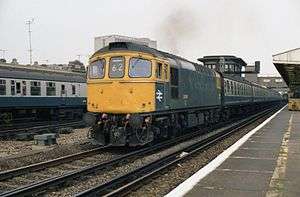 33008 passing through Woking station, circa 1978, with a train of Mk 1 coaching stock. | |||||||||||||||||||||||||||||||||||||||||
| |||||||||||||||||||||||||||||||||||||||||
| |||||||||||||||||||||||||||||||||||||||||
| |||||||||||||||||||||||||||||||||||||||||
| |||||||||||||||||||||||||||||||||||||||||
They were produced as a more powerful Type 3 (1,550 bhp) development of the 1,160 bhp Type 2 Class 26. This was achieved, quite simply, by removing the steam heating boiler and fitting a larger 8 cylinder 8LDA28 version of the previous 6 cylinder engine. This was possible because of the traffic requirements of the Southern Region: locomotive-hauled passenger traffic depended on seasonal tourist traffic and was heavier in the summer, when carriage heating was not needed. In the winter, their expected use was to be for freight. Thus, they became the most powerful BR Bo-Bo diesel locomotive.[1] The perennially unreliable steam heating boiler could also be avoided.
A total of 98 were built by the Birmingham Railway Carriage and Wagon Company (BRCW) and they were known as "Cromptons" after the Crompton Parkinson electrical equipment installed in them.[2] Like their lower-powered BRCW sisters, the 26 and 27 classes, their bodywork and cab ends were of all steel construction. They were very similar in appearance to class 26 locos, but carried Southern Region two-digit headcode blinds between the cab windows.
The original (1957) number sequence was D6500–D6597.[3]
Design
Electric Train Heating (ETH)
The electrical heating system worked at a DC voltage of 800 V, with a generator capacity of 235 kW. As this was early days for ETH on BR, standards were not yet clear and there was a possibility in this region of a future need to heat continental stock from boat trains. Both two pole and single pole systems were supported; two pole becoming the standard on BR but some continental stock using a single pole system with return through the rails.[4]
Electrically, the main traction generator was separate from the heating generator, although both were built mechanically as part of the same machine. A third auxiliary generator of 57 kW was arranged similarly, to provide a supply for the traction motor cooling blowers, pumps, brake exhausters etc. The electrical rating for traction power was the same whether heating was in use or not, but the excess engine power now became available for traction.[4]
Avoiding the weight of the boiler and its water and fuel supplies allowed the diesel fuel capacity to be increased from 500 gallons to 800 gallons, compared to the Type 2s.[4]
Early years
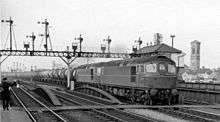
| Code | Name | Quantity |
|---|---|---|
| EH | Eastleigh | 49 |
| HG | Hither Green | 47 |
| Withdrawn (1964–68) | 2 | |
| Total built: | 98 | |
The locomotives were initially needed, unusually, because of an electrification scheme. The 'Kent Coast scheme' was one of five major electrification schemes put forward by the 1955 Modernisation Plan. This scheme would remove steam from Kent, with it replaced by electrification on the heavily-trafficked lines and diesel-electrics on the remainder.[4][6]
The locomotives began service on the South-Eastern Division of the Southern Region but rapidly spread across the whole Region and many were used much further afield – an example being the weekly Cliffe (Kent) to Uddingston (South Lanarkshire) cement train which they worked as far as York (and occasionally throughout) in pairs.
Only the then new electric train heating was fitted, rather than the ubiquitous steam heating which passenger carriages largely used. Early delivery problems and a shortage of steam locomotives resulted in many Class 24 locomotives being borrowed from the Midland Region and pairs, of 33 + 24, became common on winter passenger services. This resulted in unpopular, complex run-round manoeuvres at termini as the Class 24 needed to be coupled inside to provide steam heat. Emergency provisioning of through-piping for steam heat on some examples of class 33 alleviated this somewhat. The Southern Region was unaccustomed to the operational overhead and maintenance associated with the use of class 24 and they rapidly became unpopular. With the advent of modern stock and warmer seasons, they were returned to the Midland Region.
Fleet summary
Fleet summary 2018
| Owner | Number | Numbers | Notes |
|---|---|---|---|
| West Coast Railways | 4 | 33025, 029, 030* and 207.[7] | *Spares donors. |
| Total | 4 |
Sub-classes
There were three variants, later becoming Class 33/0, 33/1 and 33/2.
Class 33/0 – standard locomotives
All 86 of the first delivery were built as standard locomotives, numbered D6500 to D6585. Under TOPS they became class 33/0 and the surviving locomotives, excluding the 19 that were push-pull fitted, were renumbered 33 001–33 065. Two accident-damaged locomotives were withdrawn before TOPS took effect.
Class 33/1 – push-pull fitted locomotives
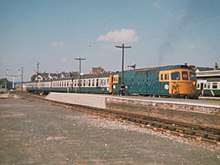
While third rail electrification was expanding on the Southern region, it was not then considered to be justified to extend beyond Bournemouth and so, in 1965, D6580 was fitted with experimental push-pull apparatus, high-level brake pipes and jumper cables to make it compatible with Multiple Unit stock. Commencing 21 July 1965 tests were carried out between Wimbledon Park and Basingstoke and then, from 17 January 1966, on the Oxted Line, using a 6-coach rake of unpowered multiple unit coaches (designated TC, standing for Trailer Control). The use of this equipment removed the necessity for the locomotive to run around to the front of its train at each terminus, as it could be controlled from the driving position of a TC unit and hence could propel its train from the rear.
Following successful completion of trials, D6580 and a further eighteen other members of the class (D6511, D6513, D6514, D6516, D6517, D6519, D6520, D6521, D6525, D6527, D6528, D6529, D6531, D6532, D6533, D6535, D6536 and D6538) entered Eastleigh Works, to be fitted with a modified version of the push-pull apparatus – fully compatible with Class 73 and Class 74 electro-diesels and indeed any electro-pneumatically controlled (EP) multiple unit stock. They emerged, painted in the new BR corporate blue with full yellow ends. D6521 had re-entered service by November 1966, so equipped, and by November 1967 the remainder had returned to traffic fitted for push-pull working. [8]
With the advent of TOPS, Class 34 was originally reserved for these modified locomotives - but it was not used and they were grouped, instead, into class 33/1 and the nineteen locomotives were renumbered, sequentially, in the range 33101–33119.
They settled into sterling service, proving themselves highly useful and reliable. The prototype locomotive (D6580, later 33119) was the only member of Class 33 to run in green livery with the multiple unit control equipment – not to be confused with preserved members of Class 33/1 that have been repainted into green.
Class 33/2 – narrow-bodied locomotives
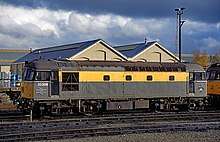
The final batch of twelve locomotives was built with narrow bodies, to allow them to work through the narrow tunnels between Tunbridge Wells, in Kent, and Hastings, in East Sussex. The "Hastings profile",[9] required the bodies to be reduced in width by 7 inches (178 mm) to avoid clipping tunnel linings on that line, leading to their nickname of 'Slim Jims'.[10] Originally numbered D6586 to D6597, they were later renumbered 33201 to 33212.
The high cost of re-tooling the jigs and fixtures for construction of these narrow bodies was extensive and based on the very small number of locomotives, was financially painful to BRCW. This and other order book issues with the rolling stock business contributed to the bankruptcy of the business.
Push-pull operations
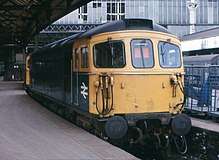
The mainstay of push-pull operations was the operation over the then un-electrified track from Bournemouth to Weymouth and the service continued like this across three decades. Weymouth trains started at London Waterloo powered by third-rail electric traction via Winchester and Southampton to Bournemouth. The consist was normally twelve cars made up of a powerful 3,200 hp (2,400 kW) 4REP electric multiple unit on the rear with two leading units of un-powered 4TCs. At Bournemouth the train would be divided with the 4REP remaining at the London end of Bournemouth station and the 4TCs hauled onward to Poole and Weymouth by Class 33/1. On the return leg, the locomotive propelled the train back to Bournemouth where it would be attached to a waiting London-bound 4REP and the locomotive detached to await the next Weymouth-bound portion.
The usual configuration was 4TC+4TC+Loco with the locomotive at the country end. Light traffic would result in 4TC+Loco, and in rare operational circumstances 4TC+Loco+4TC was noted. This combination was not preferred, as it led to operational difficulties and inconvenience to waiting passengers who found themselves confronted with the side of the locomotive when their train has drawn to a halt.
The Class 33/1 with one or two 4TC sets (normally with the Class 33/1 at the country end of the train) were also the mainstay of the Waterloo – Salisbury service from their introduction. Platform congestion and the lack of facilities at the very busy Basingstoke station were two of the reasons for class 33/1 operation throughout the route rather than just over the non-electrified section west of Basingstoke.
In later years Weymouth boat trains, conveying passengers between London and the Channel Islands ferry service out of Weymouth, were handed over to push-pull operation. The section of route from Weymouth to the ship terminal at the quay is actually tramway, following (and largely in the middle of) the harbour road. The quay spur did not pass through the station, but diverged westwards at the throat thus it was not possible for boat trains to call at Weymouth station. Boat trains had been made up of conventional coaching stock and the locomotive would run-round its train on arrival at the sea-terminal. The move to push-pull sets on boat trains removed two headaches for the SR:
- The necessity for the run-round at the quay was removed.
- The locomotive swap at Bournemouth (for both up and down trains) was eliminated and services were greatly improved with the removal of the troublesome Class 74 locomotive from the equation.
Although class 73 and 74 electro-diesel locomotives had push-pull capability, they did not have the endurance for longer runs on diesel power – their 600/650HP was not even Type 1 – little more than a high-powered shunter equivalent. The Type 3 power of Class 33/1 with only a 4 or 8 car train was rarely into the recovery margin of a schedule due to load.
Class 33/1 and 4TC combinations were often used to supplement other services and were not just the purview of Bournemouth-Weymouth trains. Services could be rostered for a push-pull set due to stock shortages – the Reading to Basingstoke service (normally a stronghold of DEMU sets) could be relied upon to produce a push-pull set on Sundays. Often, electric rosters would be substituted by class 33/1 + 4TC if the line was de-energised during engineering work. Indeed, push-pull sets were a possibility over the entire range of Southern Region services including inter-regional trains; they were not in-frequent visitors to Bristol Temple Meads and have been noted at Cardiff.
Although in private ownership at the time, 33103 and 4TC 417 were spot-hired for use on Barking-Gospel Oak services during a stock shortage in 1999 and worked the service for some weeks without issue.
A further member of the class, 33115, was used as a dead-load test before the introduction of Eurostar trains running on Southern tracks into Waterloo, with running number 83301. Having been fitted with Eurostar bogies (complete with electric 3rd rail collector shoes), it formed part of a test train where its through-wiring for push-pull work was necessary for the completion of tests.
Tramway safety
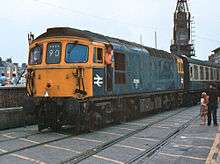
Allocated to work the Weymouth Harbour Tramway, trains operating over public thoroughfare tramway without escort are required to be fitted with warning equipment for the general public. Before its withdrawal, the Class 03 Weymouth pilot would regularly take fuel-oil tank wagons (for the ferries) and occasionally boat-train stock between Weymouth yard and ferry terminal. It had a bell and beacon fitted at both ends above the lower-centre headcode lamp (along with SR style high-level brake pipes) which served to warn thoroughfare users and was controlled from the cab. For main-line stock, two warning units were built and housed in a cabinet at the track side of the quay spur at the throat of the yard. This equipment comprised a yellow control box with amber rotating beacon and bell which fitted on a bracket just above the rubbing plate on the cab front. Class 33/1 and all TC stock were equipped with this bracket and a socket where units plugged-in to draw power from the train systems. This was a specific complexity with the two types and in order to standardize and remove a maintenance risk, in the early 1980s, three battery-powered units were constructed which mounted on a standard lamp bracket with no need to draw power from the train. This allowed the power and control circuitry for warning units to be removed during (and thus simplifying) overhaul. The old power sockets were gradually removed and plated-over but some remained until withdrawal of the stock. These new units also enabled other types of stock to use the tramway. They were smaller, had an on/off switch on the rear of the unit and no bell – warnings being given using the train horn.
Trains for the quay would halt at the station throat, and the warning equipment was attached and tested by the train guard. In addition, trains on the tramway were "walked" by railway staff with flags, clearing the route of people and badly parked cars all the way between the points at which the tramway reverted to conventional track at the quay station and road crossing into Weymouth yard. On arrival at the quay terminus the guard would move the warning equipment to the other end of the train in readiness for the return journey. In later years, (e.g. for Railtours) the local Police fulfil the role of traffic control and the process of moving a train along the tramway has become a lot less routine.
Accidents and incidents
- On 23 March 1960, locomotive D6520 was hauling a freight that was derailed between Burghclere and Highclere, Hampshire.[11]
- On 5 March 1964, locomotive D6502 was hauling a freight train when it ran through signals at Itchingfield Junction, West Sussex and was in a rear-end collision with a freight train. Two people were killed. Damage was so extensive that the locomotive was cut up on site.[11]
- On 30 September 1966, locomotive D6535 was hauling a freight train that overran signals and was derailed by trap points at Wallers Ash, Hampshire.[11]
- In 1968, locomotive D6576 was involved in a collision at Reading, Berkshire. Following recovery to Eastleigh Works and examination, it was considered uneconomical to repair and was cut up for spares.
- On 4 January 1969, locomotive No. D6558 was hauling a parcels train that was run into by a passenger train at Marden, Kent.
- On 28 July 1971, locomotive No. 6561 was hauling a parcels train that was derailed at Guildford, Surrey.[12]
- In September 1975, locomotive No. 33041 was involved in an accident in London and was consequently written off.[13]
- On 11 October 1977, locomotives No. 33036 and 33043 were hauling a freight train that was derailed at Mottingham, London. Due to damage sustained, 33036 was withdrawn from service and scrapped.[14][15]
- On 25 February 1979, locomotive No. 33115 was hauling a passenger train which was involved in a collision with an engineers' crane near Hilsea. One person was killed in the accident. 33115 was out of traffic until 1980.[16]
- On 26 January 1985, locomotive 33104 ran into the rear of a passenger train formed of 4VEP units 7754 & 7703 and 4CIG unit 7395 which had been halted by a landslip near Popham, Hampshire. The crew of the passenger train had failed to protect the rear of their train, Twelve people were injured. The locomotive was written off.[17]
- On 24 March 1987, a freight train overran a signal at Frome North Junction, Somerset. Locomotive No. 33032 was hauling a passenger train that was in a head-on collision with the freight train (hauled by 47202). Fifteen people were injured, some seriously.[18][19]
Preservation
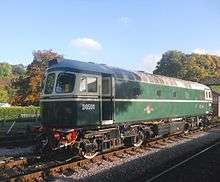
Twenty-nine locomotives have been preserved. [20]
| 1957 number | TOPS number | Name | Location | Current Status | Livery |
|---|---|---|---|---|---|
| D6501 | 33002 | Sea King | South Devon Railway | Operational | BR Green (Yellow Warning Panels) |
| D6508 | 33008 | Eastleigh | Battlefield Line Railway | Undergoing Restoration | BR Green (Yellow Warning Panels) |
| D6515 | 33012 | Lt Jenny Lewis RN | Swanage Railway | Operational and Mainline Certified | BR Green (Yellow Warning Panels) |
| D6530 | 33018 | – | On a private site | Undergoing Restoration | BR Blue |
| D6534 | 33019 | Griffon | Battlefield Line Railway | Under repair | DCE Grey and Yellow |
| D6539 | 33021 | Eastleigh | Churnet Valley Railway | Operational | Post Office Red |
| D6543 | 33025 | Glen Falloch / Sultan | Carnforth | Operational, Mainline Certified | West Coast Railways |
| D6547 | 33029 | Glen Loy | Carnforth | Operational, Mainline Certified | West Coast Railways |
| D6548 | 33030 | – | Carnforth | Stored (spares loco) | Direct Rail Services dark blue |
| D6553 | 33035 | Spitfire (Name not Currently Carried) | Ecclesbourne Valley Railway | Operational | BR Blue |
| D6564 | 33046 | Merlin | East Lancashire Railway | Stored (spares Loco) | South West Trains blue |
| D6566 | 33048 | – | West Somerset Railway | Operational | BR Green (Yellow Front) |
| D6570 | 33052 | Ashford | Kent and East Sussex Railway | Stored | BR Green |
| D6571 | 33053 | – | Mid Hants Railway | Operational | BR Blue |
| D6575 | 33057 | Seagull (Name not Carried) | West Somerset Railway | Operational | BR Green (Yellow Front) |
| D6583 | 33063 | R.J. Mitchell | Spa Valley Railway | Operational | Railfreight Mainline Sector |
| D6585 | 33065 | Sealion | Spa Valley Railway | Undergoing heavy overhaul | BR Blue |
| D6513 | 33102 | Sophie | Churnet Valley Railway | Operational | BR Blue |
| D6514 | 33103 | Swordfish | Ecclesbourne Valley Railway | Operational | BR Blue |
| D6521 | 33108 | Vampire | Severn Valley Railway | Operational | BR Blue |
| D6525 | 33109 | Captain Bill Smith RNR | East Lancashire Railway | Operational | BR Blue |
| D6527 | 33110 | – | Bodmin and Wenford Railway | Operational | Departmental grey |
| D6528 | 33111 | – | Swanage Railway | Operational | BR Blue |
| D6535 | 33116 | Hertfordshire Rail Tours | Great Central Railway | Operational | BR Blue |
| D6536 | 33117 | – | East Lancashire Railway | Undergoing Repairs | BR Blue |
| D6586 | 33201 | – | Battlefield Line Railway | Operational | BR Blue (Full Yellow Ends) |
| D6587 | 33202 | Dennis G. Robinson | Mid Norfolk Railway | Operational | BR Blue |
| D6592 | 33207 | Jim Martin | Carnforth | Operational, Mainline Certified | West Coast Railways |
| D6593 | 33208 | – | Battlefield Line Railway | Undergoing Repairs | BR Green (Yellow Warning Panels) |
Model railways
In 2010 Hornby Railways started to sell the BR Class 33 in its Railroad range in BR Green in OO gauge. [21]
Heljan make various BR Class 33's in OO gauge. [22]
References
- Webb (1978), pp. 43–45.
- "Class 33 – Overview". Southern E-Group (SEMG). Retrieved 16 February 2007.
- "Class 33 – Technical Details". Southern E-Group (SEMG). Retrieved 16 February 2007.
- "Type "3" Diesel Electric Locomotives for the Southern Region". The Railway Magazine. April 1960. pp. 238–241, 246.
- British Railways Locoshed Book 1974 edition. Shepperton: Ian Allan. 1974. pp. 24–25. ISBN 0-7110-0558-3.CS1 maint: ref=harv (link)
- "Kent Coast Electrification Scheme". Southern Electric Group.
- http://www.brdatabase.info/locoqry.php?action=class&id=30&type=D&page=fleet
- Various Modern Railways magazine of the period
- Marsden, Colin J (November 1986 – January 1986). "The Southern Type 3's". Modern Railways Pictorial Profile. No. 11. Weybridge: Ian Allan Ltd. pp. 4–6. ISSN 0264-3642.
- Modern Railways Pictorial 1986, page 115
- Bishop, Bill (1984). Off the Rails. Southampton: Kingfisher. pp. 65–68, 83–87. ISBN 0 946184 06 2.
- Earnshaw, Alan (1991). Trains in Trouble: Vol. 7. Penryn: Atlantic Books. p. 44. ISBN 0-906899-50-8.
- Trevena, Arthur (1981). Trains in Trouble: Vol. 2. Redruth: Atlantic Books. p. 33. ISBN 0-906899-03-6.
- Hoole, Ken (1983). Trains in Trouble: Vol. 4. Redruth: Atlantic Books. pp. 44–45. ISBN 0 906899 07 9.
- Butlin, Ashley. Diesels and Electrics for scrap. Penryn: Atlantic Books. p. 30. ISBN 0 906899 27 3.
- HM Railways Inspectorate. "Report on the Collision that occurred on 25th February 1979 between Hilsea and Fratton in the Southern Region British Railways" (PDF). Railways Archive. Retrieved 17 February 2015.
- McCrickard, John P (16 October 2016). "January 1982 to May 1986". Network South East Railway Society. Archived from the original on 26 June 2018. Retrieved 26 June 2018.
- Vaughan, Adrian (2003) [2000]. Tracks to Disaster. Hersham: Ian Allan. pp. 10–11. ISBN 0 7110 2985 7.
- Department of Transport (6 May 1988). "Report on the Collision that occurred on 24th March 1987 at Frome" (PDF). Her Majesty's Stationery Office. Retrieved 21 March 2017.
- "Archived copy". Archived from the original on 29 February 2008. Retrieved 2 February 2008.CS1 maint: archived copy as title (link)
- "Hornby BR Class 33". Hornby Railways Collector Guide. Retrieved 1 February 2020.
- "Heljan BR Class 33". Heljan catalogue. Retrieved 22 April 2020.
- Marsden, Colin J. (1981). Motive power recognition:1 Locomotives. Shepperton: Ian Allan Ltd. ISBN 0-7110-1109-5.
- Stevens-Stratten, S.W.; Carter, R.S. (1978). British Rail Main-Line Diesels. Shepperton: Ian Allan Ltd. ISBN 0-7110-0617-2.
- Williams, Alan; Percival, David (1977). British Railways Locomotives and Multiple Units including Preserved Locomotives 1977 Combined Volume. Shepperton: Ian Allan Ltd. ISBN 0-7110-0751-9.
- McManus, Michael. Ultimate Allocations, British Railways Locomotives 1948 – 1968. Wirral. Michael McManus.
- Webb, Brian (1978). Sulzer Diesel Locomotives of British Rail. David & Charles. ISBN 0715375148.CS1 maint: ref=harv (link)
Further reading
- Cooper, B.K. (1990). Locomotive Profile: Class 33 'Cromptons'. Ian Allan. ISBN 9780711018945. OCLC 24733799.
- Hypher, John (1991). The Class 33's: A Celebration of Thirty Years. Runpast Publishing. ISBN 9781870754194. OCLC 60054445.
- Marsden, Colin (2005). Rail Portfolios: The Cromptons. Ian Allan. ISBN 9780711031029. OCLC 58829151.
- Vaughan, John (2008). Diesel Retrospective:Class 33. Ian Allan. ISBN 9780711032842. OCLC 185031160.
- Kelly, Peter (February 1983). "Workaday wonders". Rail Enthusiast. EMAP National Publications. pp. 4–5, 7–9. ISSN 0262-561X. OCLC 49957965.
- Hypher, John (October 1984). "Cromptons far and wide - Occasionally slim!". Rail Enthusiast. EMAP National Publications. pp. 34–39. ISSN 0262-561X. OCLC 49957965.
- Dunn, Pip (18 June – 1 July 1997). "The small locomotive with the big personality!". RAIL. No. 307. EMAP Apex Publications. pp. 20–25. ISSN 0953-4563. OCLC 49953699.
External links
| Wikimedia Commons has media related to British Rail Class 33. |
